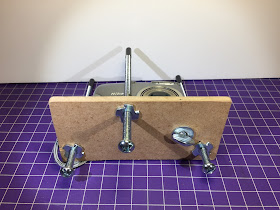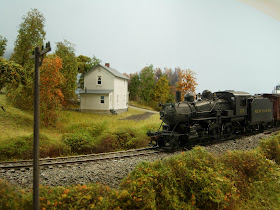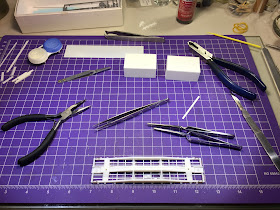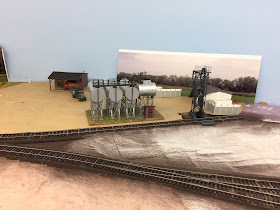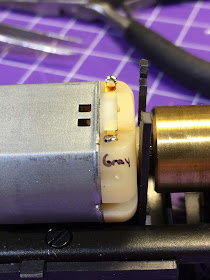All heady from my
first decoder install (despite the poor running result, which is likely the result of a poor mechanism rather than my installation), and having built some confidence in my soldering ability, I decided to tackle a harder project (harder since I had no sample to use as a guide) - converting an old Frateschi New Haven Alco FA-1, imported from Brazil by E-R Models back in the late 80's/early 90s. Apparently, "
they used to produce US product for Atlas until Atlas took the work to China" so I figured it'd be a good candidate for conversion.
This model isn't Atlas/Kato smooth, but it runs really well considering its vintage. Yes, this time I tested it thoroughly on DC before starting the conversion. Besides, I need some more road freight diesels for the Shore Line.
The shell comes off easily enough - just spread the sides to clear the lugs, lift up the back and slide forward. When you do, this is what you see:
Very old school - the "PCB" is really just a way to save wiring, I suppose. There's nothing on there but traces for the wires to solder to. Unfortunately, the motor terminals are soldered directly to this board.
Removing the wires was easy enough - just touch the iron to the solder and pull the wire - but disconnecting the board from the motor required desoldering braid to remove all the solder and free the board.
Took some effort, but I was finally able to remove it.
Before removing all the wires, I had noted which motor terminal was connected to which side of the track pickup/trucks. On this model, it ended up being counter-intuitive: the right motor terminal, which would normally connect to the right/red side of the trucks and be attached to the orange wire from the decoder, actually connected the left side. And vice-versa. So to keep things straight, I used a Sharpie to mark that this terminal required the
gray decoder wire rather than the orange.
Gray wire successfully soldered and insulated from its surroundings with a piece of shrink tube.
(Un?)Fortunately, things progressed very quickly from this point on as I briskly fluxed/tinned/soldered connections to get things finished much more quickly than my previous install. So I didn't take any more pictures until I was about finished.
 |
| iPhone speaker, upside down for clearance, and ESU/Loksound Select decoder |
What I did though was make a styrene mounting board like I did for the DL-109. This one was fashioned as a replacement for the PCB I'd removed, using .060" thick styrene, cut to .485" wide (to slide through the existing mounts above the motor) and 3.25" long (to provide enough support for the decoder and speaker, while not going into the cab area). Double-sided foam tape and Kapton tape completed the installation - well, except for the headlight.
Speaking of the headlight.... I used a 3mm clear white LED with a 1k resistor soldered on the cathode (- side of the LED). I would really have rather used a "warm white" or "sunny white" LED for a warmer, less bright white tone, but my local shop didn't have any. If you have any recommendations for what you'd use, please let me know!
Fortunately, the brightness of the LED can be adjusted on the ESU decoder and I dialed mine back to a level 10 (from a default value of 31). That toned the brightness down to an acceptable level, but it's still very white. If I find LEDs that look more like the "Golden Glow" headlights I've seen in color photos of New Haven diesels, I'll have no problem changing them all out. The hard work is already done.
Here's a shot of the completed installation, with the headlight installed.
And a closeup, showing the resistor, twisted headlight leads, and shrink tubing to keep everything isolated. You'll also notice that I cut back the LED leads quite a bit, opting for wire rather than the stiff leads for easier clearance.
Having finished one, and having another to do, I jumped right in.... Here's the second one on deck...
And a finish photo below...
This time I opted to place the resistor further away from the decoder, at the risk of it showing in the cab. I don't know how much heat the resistor will give off - and the decoder produces heat too - so I figured separating them would be a good idea.
Things apparently were going All Too Well though - so Mr. Murphy decided to give my smugness a little slap. As I was attempting to put the shell back on the second locomotive, I managed to break off the rear coupler mount!
So here's the chassis, supported by two blocks of wood (rather than a foam cradle, which might hurt my decoder wiring), with the broken mount/coupler off to the side.
A closeup of the break. I'm going to try using contact cement to repair this, but given the strain/tension that this mount may have to endure hauling long freight trains, I don't know how well that will work or how long it'll last. In the meantime, I'm going to try to find some 1/4" square styrene to fabricate a new mount.
And if that wasn't "fun" enough - part way through this process, this happened:
That's my
entire 3-drawer tool/supply cabinet spilled onto the floor(!) Another rookie mistake - having the two heaviest drawers pulled out at the same time and expecting it
not to fall. %^)
All in all though, these decoder installs have been incredibly satisfying. I've succeeded in removing the mystery that had prevented me so long from even trying it - and now I'm, well, not a "veteran" but I certainly know how to do it. And HAVE done it, three times now. I don't know how long it'll take me to attempt an install on an old brass steam locomotive, but I'm fairly confident now that I can take care of most diesel installs. And that's a pretty cool place to be.
Hopefully my story will encourage some of you to give it a try - and if you do, be sure to let us know so we can cheer you on!

















